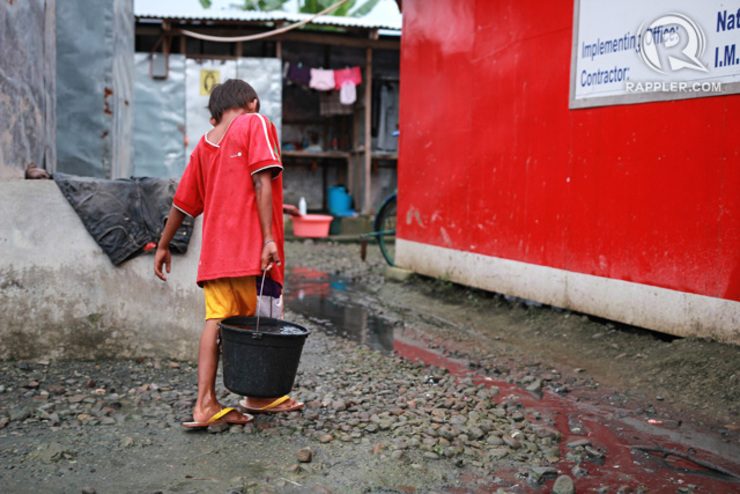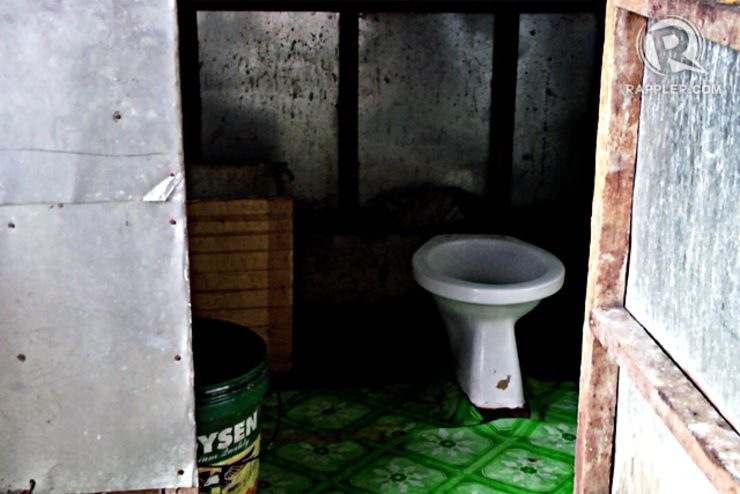SUMMARY
This is AI generated summarization, which may have errors. For context, always refer to the full article.

PALO, Philippines – Wearing a loose red shirt, 9-year-old Joel Tapado strained his arms to carry a pail of water in a bunkhouse community for Yolanda (Haiyan) survivors in Palo, Leyte.
Joel used the pail, which was around a quarter his size, to get water from a common faucet. He brought this to one of the bathrooms shared by 270 families, or more than 1,260 people, in the bunkhouse community at the government center in Palo.
Going back and forth, Joel fetched 7 pails of water to fill a huge styrofoam container in the bathroom. His family would use this to take a bath, flush the toilet, or rinse the floor.
By doing this, Joel is helping make sure their village is clean. True enough, bathrooms here look hygienic – no leftover feces and or even foul smell. It’s one of the signs that after months of living here, Yolanda survivors have adjusted to these temporary shelters, each as big as 4 ping-pong tables.
Still, Yolanda survivors see these bunkhouses both as a blessing and a curse.
“Parang okay, parang hindi,” said Joel’s mother, Lorena, in an interview with Rappler on Monday, November 3. (It seems okay, it also seems not.)

‘We haven’t recovered’
Lorena, 35, lives with 6 of her children in their bunkhouse unit. Her eldest is 15 and her youngest, one year old. She had a 7th child who was born on Friday, October 31. The baby died on Saturday, November 1, after suffering a heart problem while in Lorena’s womb.
“Ganu’n talaga ang buhay. Wala tayong magagawa,” she said. (That’s how life really is. We can’t do anything about it.)
Despite heartbreaks like this, Lorena said there is much to be thankful for. For one, she is happy about the bunkhouse because, at least, they have a roof over their head.
At the same time, however, Lorena pointed out a downside: the price of commuting from their bunkhouse to her husband’s workplace and her children’s school.
Others said the bunkhouses lack the amenities, such as television sets and furniture, in their former homes.
“Mahirap dahil parang hindi pa kami nakakabangon mula nu’ng Yolanda,” she said. (It’s hard because it seems we haven’t recovered since Yolanda.)
Like Lorena, around 420 families remain in bunkhouses in Palo alone, said Palo Mayor Remedios Petilla. This is equivalent to 1,880 persons.
Take a minute-long video tour of a Yolanda bunkhouse:
‘Better than none’
On Monday, Petilla told Rappler that most of these families will soon transfer to permanent shelters built by groups such as the Buddhist Tzu Chi Foundation and the GMA Kapuso Foundation.
Tzu Chi is finishing 265 permanent shelters, she said, while GMA is constructing 175.
She said around 400 houses will also rise in another area in Palo.
Palo needs to build around 900 permanent shelters not only for those in bunkhouses, but also those still living in hazard zones such as riverbanks and creeks. (READ: Yolanda a year after: Only 2% of needed houses to be built by Nov 8)
“The bunkhouses are very temporary – very, very temporary,” Petilla said in Filipino.
Luzviminda Secuya, 60, also a bunkhouse resident in Palo, said a bunkhouse is better than none.
Secuya said: “Mabuti na lang may natutulugan. Mabuti na rin may bahay kami. Kahit na walang cash assistance, basta buhay lang kami.” (It’s good enough we have a place to sleep in. It’s good enough we have a house. Even without cash assistance, what’s important is that we’re alive.) – With reports from Franz Lopez/Rappler.com
For Rappler’s full coverage of the 1st anniversary of Super Typhoon Yolanda (Haiyan), go to this page.
Add a comment
How does this make you feel?
There are no comments yet. Add your comment to start the conversation.